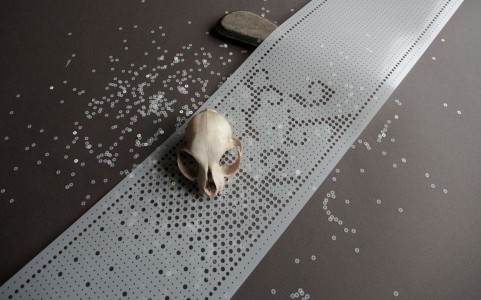Patterns to punctuate speech, with darkness.
‘Punctuation is part of the mechanics of writing.’
(Gerard Salton)
‘You punctuate your speech with nails, with glass, with mirrors, with chrome. With sharpness and always some danger of a stab or a jagged edge. You punctuate your speech with darkness.’
(Anne Waldman)
In this lecture performance,
I once more explore the potential of punctuation as an artistic principle for the compositional process. For the video online, a performance version (with voice & contrabass recorder) was recorded. My performance can only be watched during a live-setting.
Patterns to punctuate speech: a phenomenology of composing. from Palmeworks on Vimeo.
I wrote an essay and a poetic text in German and English, for this performance. I took a video of myself, handwriting or using a punch tool to fabricate patterns on a punchcard roll, something which is being used to control knitting machines.
The process of punching holes
is similar to how I compose. I punch a single hole at a time, yet there is a sense of an ongoing action taking place. I start from single thoughts, sounds, into more & more complex structures. There is a characteristic sound from the punch tool, a rhythm. The pattern recorded for the video is ‘improvised’, I had no plan. I started from the empty punchcard score. In composing, I start from silence.
I comment what I do. The holes I punch can form into patterns, if their number increases. I argue that perception as an enactive process joins single events into patterns. The extraordinary punctuates the habitual. I investigate how I evaluate the potentiality of a group of holes to turn into a pattern. The third hole is crucial; the eye or the ear joins the single events into a figure, a rhythm.
An alpine landscape. My hands, punching. Texts. I add live instrumental sound, I perform with my contrabass recorder. The instrument punctuates voice and electronics. I perform the text and contrabass recorder at the same time, in some passages literally simultaneous.
What I do as an artist is rooted in Austria’s recent history. The country where I come from is exquisitely beautiful. Austria has a rich musical tradition. Underneath the beauty, there is darkness. Things are hidden. This is not what tourists are supposed to see. But I listen to the hidden voices.
At school, I learned the art of female handcrafting. Pattern-making. Stitch by stitch. What I work on will not be a pleasant pattern to look at. No decoration. I punctuate the beauty of the landscape to vent the wrath underneath.
Punctuation is a step towards complexity and depth in my work & life. Patterns unfold as the process continues. This is a very personal journey, yet quite Austrian, too.
References:
Salton, G. (1958) The Use of Punctuation Patterns in Machine Translation. in: Mechanical Translation, vol.5, no.1, July 1958; pp. 16-24. Available at:
Waldman, A. (2011) The Iovis Trilogy: Colors in the Mechanism of Concealment. Minneapolis: Coffee House Press.
Text (excerpt)
where does form
begin
& random appearance end?
one after the other
stitch & punch & stab
& stitch & punch & stab
& again
ich stick euch ein Tuch
mit Mustern
die ihr nicht
werdet sehen wollen
until the pattern
becomes visible
over
the beauty
the lush green grass
it is good to look at
a pattern
manifest
the sound of my voice
and my instrument
makes me feel calm
I sing when it is dark
to punctuate fear with audacity
das Tuch leg ich
über die schöne Landschaft
deck sie zu
& settle down
beyond ambiguity
